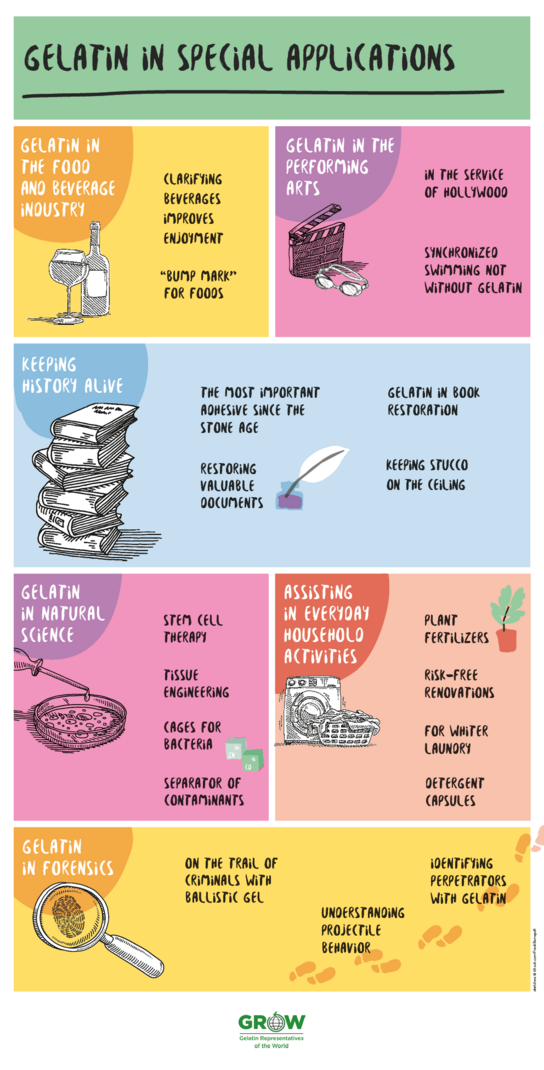Many branches of industry reap the benefits

Gelatin is an indispensable all-rounder that is used in countless products and applications. Most people only associate gelatin with desserts and fruit gums. However, gelatin also plays an important role in various technical applications. Collagen peptides as well are used for an extensive range of products and applications. Through its diverse properties and functionalities, final consumers reap benefits that were unimaginable many years ago.
Gelatin is universal and the raw material for innovations
Not only the food, pharmaceutical and photographic industries fall back on gelatin for its healthy and functional properties. A large number of other industrial branches benefit from the positive properties of this natural product. The following examples demonstrate the wide spectrum of possible applications.

-
Clarifying beverages improves enjoyment
Wine is expected to be clear and free of visible foreign substances or haze particles. However, at the end of its fermentation process, wine is opaque and not the nice golden yellow or ruby red consumers would like it to be. This brew therefore undergoes a special treatment called fining or clarifying. Specially processed edible gelatin is an effective processing aid for clarifying wines. The gelatin binds with the tannins of the wine to form insoluble flakes, enclosing the haze particles and precipitating them out of the wine. These are then completely be removed prior to bottling. Gelatin acts as an aid (processing aid) to get rid of the fine particles and turbid materials.
-
“Bump Mark” for foods
A student at Brunel University in Great Britain has developed a so-called “Bump Mark” composed of gelatin. The mark is filled with gelatin and contains little bumps. As long as the gelatin remains solid, the bumps cannot be felt. However, as the food approaches its date of expiration, the gelatin begins to decay and becomes fluid, which means that consumers can clearly feel the bumps with their fingers. Gelatin “ages” in a manner similar to milk, meat or cheese. The different shelf lives of the various foods can be taken into account by varying the amount of gelatin in the label. Especially for consumers with visual impairments, the “Bump Mark” could be a huge help. In addition, it could help prevent food waste, as it is more reliable than a printed expiration date.
-
In the service of Hollywood
Gaping flesh wounds, burnt skin, disfigured faces: Gelatin has long been used by make-up artists to portray all types of wounds and skin changes. And despite it being the era of computer animation, Hollywood is still using gelatin in its film and television productions – and not only for masks. Quite a few of the “organs” seen on the dissecting tables of forensic investigators in TV series are made of dyed gelatin. What is known as “special effects” gelatin can also be used to cover inconvenient hair growth and eyebrows as well as to create tonsures in real hair. The benefits of this material are obvious: gelatin is a flexible and inexpensive material that is easy to work with and dye.
-
Synchronized swimming not without gelatin
Synchronized swimming is not about achieving fast times. Instead, it is all about elegance. Which is why the make-up artist is the first stop before any competition. More than anything else, the hairdo must stay in place. However, there are not a lot of styles to choose from. The chignon is a must. For those with thin or short hair, an artificial hairpiece can help. Liquid gelatin is then applied to the hair. It hardens as it dries and keeps every strand of hair in place.
-
The most important adhesive since the Stone Age
Gelatin has been one of the most important adhesives since the Stone Age. Even today, special gelatin is still used in the preservation of historical monuments as a historic binding agent for distempers and as a binding agent for paints. The adhesive strength of good gelatin can equal up to 1.6 tons per square centimeter. In contrast to synthetic adhesives, a glue made with gelatin can effortlessly be loosened at any time by applying heat and moisture, all without doing any damage to the workpieces.
-
Gelatin in book restoration
Gelatin is also used in the field of book restoration because its adhesive strength and elasticity can easily be regulated. It can also be removed again with little effort and does not leave a residue, which is especially important for paper restoration. The acid wood glue applied in the 19th century is now making valuable folios in archives and libraries become brittle and fall apart. Gelatin is used here as a “natural adhesive” to mend cracks or re-glue.
-
Gelatin keeps stucco on the ceiling
Thanks to its stability as well as its elastic binding properties, gelatin is ideal for restoring or fortifying crumbling stucco ceilings. Plasterers use it to treat ornate plasterwork surfaces. Using a natural hairbrush, warm, viscous gelatin is applied to the stucco marble surface between several sanding treatments and then processed. This treatment is called “fine filling”. When entire pieces have to be recreated, the gelatin is directly mixed into the marble. This ensures that it does not harden as quickly, making it easier to work with. Fun Fact: in the Sistine Chapel in Rome, the gelatin paste used by conservators keeps Michelangelo’s paints looking radiant.
-
Stem cell therapy
Currently, a lot of research is underway to apply stem cells for treatments for neurodegenerative diseases and conditions such as diabetes and heart disease. For such therapies, stem cell expansion is needed to produce large numbers of tissue-specific stem cells. This can be done in 2D and 3D and both culturing techniques rely on suitable biomaterials to create a biomimicking microenvironment for stem cells. Since gelatin is derived from the natural extracellular matrix, it is well suited as a building block for generating advanced biomaterials such as nanostructured biomaterials to improve stem-cell proliferation and controlled differentiation.
-
Tissue engineering
Gelatin-based biological inks suitable for 3D bioprinting are now available for designing bioengineered tissues. These biological inks remain in their liquid form during the printing process but transform into a hydrogel upon, for example, treatment with UV light. To create these hydrogels, gelatin needs to be crosslinked and that is done by modifying the gelatin chemically or enzymatically. The degree of modification can be controlled and determines in part the mechanical strength of the resulting hydrogel and the behavior of the cells encapsulated within the hydrogels. This makes it possible to recreate the properties of natural tissues – from solid cartilage to soft fat tissue.
-
Cages for bacteria
Gelatin can also be used for an in-depth examination of the growth and behavior of bacterial communities. Scientists at the University of Texas at Austin, USA, have developed gelatin cages for germs using a laser-supported procedure. Conditions in these cages can be precisely controlled, making it possible to study the development of antibiotic resistance or therapies for infections, as Jodi Connell and her team of scientists wrote in the scientific journal Proceedings of the National Academy of Sciences (PNAS).
-
Separator of contaminants
Zinc and cadmium can be cleaned by adding gelatin to electrolytic baths. Gelatin makes it possible to separate contaminants from the materials, thus forming the basis for the manufacture of metals of high purity.
-
Plant fertilizers
Specially selected gelatins are widely used as plant fertilizers. The nitrogen content is precisely dosed through the gradual breakdown of amino acids. Thus, gelatin has a positive effect on the metabolic mechanisms of plants.
-
Risk-free renovations
Improper handling of asbestos material can pollute the air that one breathes with millions of carcinogens. When renovating buildings that have been contaminated with asbestos, the polluted surfaces are sprayed with a gelatin solution. This creates an elastic network that binds the asbestos fibers, which ensures that no asbestos escapes during its removal. When gelatin is used as a binding agent, the bound asbestos mixture can subsequently be mixed with cement. The resulting block is so hard that the asbestos fibers remain permanently bound and can thus be disposed of in accordance with the regulations.
-
For whiter laundry
A further advantage: gelatin manages to reduce the visible greying of laundry. At around 40°C, surfactants change gelatin’s structure and it encloses the emulsified dirt, leading to less grey discoloration of textiles through washing and less renewed uptake of previously removed dirt by the fabric.
-
Detergent capsules
Laundry detergents and cleaning agents need to meet contradictory requirements: They should be in as concentrated a form as possible to save packaging materials and energy costs. But also, the more concentrated the laundry detergent or cleaning agent, the more difficult it is to properly handle and measure out to lead to satisfactory results. These problems are solved by encapsulating the laundry detergent or cleaning agent: Water-soluble polymers such as gelatin make encapsulation possible. The capsule shells dissolve and break down when they come into contact with water, at which point the precisely measured dose contained within the capsule is released into the washer drum.
-
On the trail of criminals with ballistic gel
Criminalists use gelatin when neither casings nor bullets, let alone a weapon can be found at a crime scene. A special block of “ballistic gelatin” can determine which weapon or ammunition was used. It is quite similar in density and in its properties to the tissues of the human body. In order to better be able to analyze the pattern of injury, artificial bones and veins can also be embedded into the block of gelatin. Wound ballistics specialists shoot into the block of gelatin from varying distances and angles and with various weapons. They then calculate the bullet channels and the kinetic energy. These findings are compared with the victim’s wounds, making it possible for them to determine which weapon was used.
-
Identifying perpetrators with gelatin
The most well-known forensic method that involves gelatin is fingerprint recovery. The search for prints is carried out by dusting objects with a brush and powder. The powder adheres to the sweat and fat that make up the prints. Photographs are made to collect the evidence. The print is then lifted onto the gelatin coating of a special film and the film is transferred onto a document. Similar gelatin-containing films are used to lift glove, shoe, or footprints as well as tire tracks, dust prints and micro-trace evidence.
-
Understanding projectile behavior
The transparency of gelatin makes it especially easy to understand projectile behavior. It also enables specialists to film or photograph the behavior of the projectile using a highspeed camera. This type of information is also useful for military surgeons. Understanding the ballistic behavior of a projectile within the body makes it possible for them to make a more precise diagnosis. When faced with a number of patients with shot wounds, they can more quickly determine who needs treatment first.
-
Restoring valuable documents
Gelatin can also set the colors and the writing of an historical text and arrest what is known as acid ink corrosion. In this process, chemicals affect and dissolve the ink on the paper. Decay is very rapid when water is added to the mix. Gelatin can stop this process. For example, gelatin made it possible to restore the valuable original music scores that were damaged during the flooding disaster in Dresden in the summer of 2002.
Gelatin can help reinforce paper or parchment. Conservators split damaged pages into front and back pages and then reinforce them with a wafer-thin sheet of special paper. During this process, the manuscripts are first pasted to a carrier paper, from which they are “torn off” again later. Gelatin is used as an adhesive, and its reversibility makes it possible to later remove the carrier paper from the manuscript.
Want to learn more about gelatin’s unique properties and advantages?
Discover more special fields of application, properties and advantages of gelatin by watching the video series on GROW’s blog.
